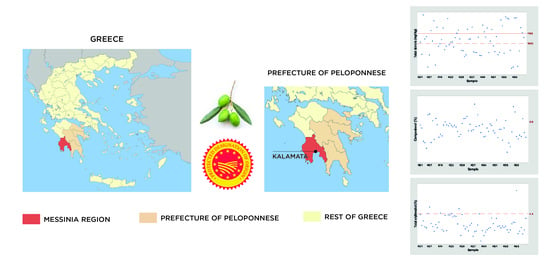Preliminary Study and Observation of “Kalamata PDO” Extra Virgin Olive Oil, in the Messinia Region, Southwest of Peloponnese (Greece)
Abstract
:1. Introduction
2. Materials and Methods
2.1. Geographical Distribution and Selection of Olive Oil Samples
2.2. Sampling and Sample Maintenance
2.3. Determination of the Physicochemical Quality Parameters
2.4. Determination of Sterols and Triterpene Dialcohols
2.5. Determination of Fatty Acid Composition
2.6. Determination of Wax Content
2.7. Statistical Analysis
3. Results and Discussion
3.1. Qualitative Parameter of Messinian Olive Oils, Greece
3.2. Analysis of Sterolic Profile and Triterpenic Dialcohol Content of Messinian Olive Oils, Greece
3.3. Fatty Acid Composition of Messinian Olive Oil, Greece
3.4. Analysis of Wax Content of Messinian Olive Oil, Greece
4. Conclusions
Supplementary Materials
Author Contributions
Funding
Acknowledgments
Conflicts of Interest
References
- Preddy, V.; Watson, R. Olives and Olive Oil in Health and Disease Prevention, 1st ed.; Academic Press: Oxford, UK, 2010; pp. 1100–1220. [Google Scholar]
- Barbouti, A.; Briasoulis, E.; Galaris, D. Protective effects of olive oil components against hydrogen peroxide- induced DNA damage. In Olives and Olive Oil in Health and Disease Prevention; Preddy, V., Watson, R., Eds.; Academic Press: Oxford, UK, 2010; pp. 1103–1109. [Google Scholar]
- Ragusa, A.; Centonze, C.; Grasso, M.E.; Latronico, M.F.; Mastrangelo, P.F.; Fanizzi, F.P.; Maffia, M. Composition and Statistical Analysis of Biophenols in Apulian Italian EVOOs. Foods 2017, 6, 90. [Google Scholar] [CrossRef]
- Borges, T.H.; Serna, A.; López, L.C.; Lara, L.; Nieto, R.; Seiquer, I. Composition and Antioxidant Properties of Spanish Extra Virgin Olive Oil Regarding Cultivar, Harvest Year and Crop Stage. Antioxidants 2019, 8, 217. [Google Scholar] [CrossRef]
- Kalogeropoulos, N.; Tsimidou, M.Z. Antioxidants in Greek Virgin Olive Oils. Antioxidants 2014, 3, 387–413. [Google Scholar] [CrossRef]
- Boskou, D. Olive Oil: Chemistry and Technology, 2nd ed.; AOCS Press: Champaign, IL, USA, 2006; pp. 45–93. [Google Scholar]
- Prospects for the Olive Oil Sector in Spain, Italy and Greece 2012–2020. Available online: https://ec.europa.eu/agriculture/markets-and-prices/market-briefs_en (accessed on 12 June 2019).
- International Olive Council Database. Available online: http://www.internationaloliveoil.org/estaticos/view/131-world-olive-oil-figures (accessed on 17 August 2019).
- Zampounis, V. Olive oil in the World Market. In Olive Oil: Chemistry and Technology, 2nd ed.; Boskou, D., Ed.; AOCS Press: Campaign, IL, USA, 2006; pp. 21–40. [Google Scholar]
- Olive Oil: Establishing the Greek brand, National Bank of Greece. Available online: https://www.nbg.gr/greek/the-group/press-office/e-spot/reports/Documents/Olive%20Oil_2015.pdf (accessed on 23 May 2019).
- Kostalenos, G. Olive Fruit Data, History, Description and Geographical Distribution of Olive Varieties in Greece, 1st ed.; Kostalenos: Poros Trizinias, Greece, 2011; pp. 1–436. (In Greek) [Google Scholar]
- Agiomirgianaki, A.; Petrakis, P.; Dais, P. Influence of harvest year, cultivar and geographical origin on Greek extra virgin olive oils composition: A study by NMR spectroscopy and biometric analysis. Food Chem. 2012, 135, 2561–2568. [Google Scholar]
- Karabagias, I.; Michos, C.; Badeka, A.; Kontakos, S.; Stratis, I.; Kontominas, M.G. Classification of Western Greek virgin olive oils according to geographical origin based on chromatographic, spectroscopic, conventional and chemometric analyses. Food Res. Int. 2013, 54, 1950–1958. [Google Scholar] [CrossRef]
- Kandylis, P.; Vekiari, A.S.; Kanellaki, M.; Grati Kamoun, N.; Msallem, M.; Kourkoutas, Y. Comparative study of extra virgin olive oil flavor profile of Koroneiki variety (Olea europaea var. Microcarpa alba) cultivated in Greece and Tunisia during one period of harvesting. LWT J. Food Sci. Technol. 2011, 44, 1333–1341. [Google Scholar] [CrossRef]
- Longobardi, F.; Ventrella, A.; Casielloa, G.; Sacco, D.; Tasioula-Margari, A.K.; Kiritsakis, A.K.; Kontominas, M.G. Characterisation of the geographical origin of Western Greek virgin olive oils based on instrumental and multivariate statistical analysis. Food Chem. 2012, 133, 1169–1175. [Google Scholar] [CrossRef]
- Pouliarekou, E.; Badeka, A.; Tasioula-Margaria, M.; Kontakos, S.; Longobardic, F.; Kontominas, M.G. Characterization and classification of Western Greek olive oils according to cultivar and geographical origin based on volatile compounds. J. Chromatogr. A 2011, 1218, 7534–7542. [Google Scholar] [CrossRef]
- Kotsiou, K.; Tasioula-Margari, M. Monitoring the phenolic compounds of Greek extra-virgin olive oils during storage. Food Chem. 2016, 200, 255–262. [Google Scholar] [CrossRef]
- Council Regulation (EC). No. 510/2006 of 20 March 2006 on the protection of geographical indications and designations of origin for agricultural products and foodstuffs. Off. J. Eur. Union 2006, L93, 12–25. [Google Scholar]
- Commission Regulation (EC). No. 1898/2006 of 14 December 2006 laying down detailed rules of implementation of Council Regulation (EC) No. 510/2006 on the protection of geographical indications and designations of origin for agricultural products and foodstuffs. Off. J. Eur. Union 2006, L369, 1–23. [Google Scholar]
- Official website of the European Union. Available online: https://op.europa.eu/en/publication-detail/-/publication/a974b890-424a-11e5-9f5a-01aa75ed71a1/language-en (accessed on 12 June 2019).
- EUR-Lex. Access to European Law. Available online: https://eur-lex.europa.eu/legal-content/EN/TXT/?qid=1574338279830&uri=CELEX:52012XC0626(03) (accessed on 12 June 2019).
- Messinia Perfecture. Available online: https://el.wikipedia.org/wiki/%CE%9D%CE%BF%CE%BC%CF%8C%CF%82_%CE%9C%CE%B5%CF%83%CF%83%CE%B7%CE%BD%CE%AF%CE%B1%CF%82 (accessed on 12 June 2019).
- Commission Regulation (EEC). No. 2568/91 of 14 July 1991 on the characteristics of olive oil and olive-residue oil and on the relevant methods of analysis. Off. J. 1991, L208, 1–8. [Google Scholar]
- Antonini, E.; Farina, A.; Leone, A.; Mazzara, E.; Urbani, S.; Selvaggini, R.; Servili, M.; Ninfali, P. Phenolic compounds and quality parameters of family farming versus protected designation of origin (PDO) extra-virgin olive oils. J. Food Compos. Anal. 2016, 43, 75–81. [Google Scholar] [CrossRef]
- Egea, P.; Pérez y Pérez, L. Sustainability and multifunctionality of protected designations of origin of olive oil in Spain. Land Use Policy 2016, 58, 264–275. [Google Scholar] [CrossRef]
- Moreau, R.A.; Norton, R.A.; Hicks, K.B. Phytosterols and phytostanols lower cholesterol. Inform 1999, 10, 572–577. [Google Scholar]
- Morchio, G.; De Anreis, R.; Fedeli, E. Investigations on total sterols content in the olive oil and their variation during the refining process. Riv. Ital. Delle Sostanze Grasse 1987, 64, 185–192. [Google Scholar]
- Boskou, D.; Tsimidou, M.; Blekas, D. Olive oil composition. In Olive Oil Chemistry and Technology; Boskou, D., Ed.; AOCS Press: Champaign, IL, USA, 2006; pp. 41–72. [Google Scholar]
- López-Miranda, J.; Pérez-Jiménez, F.; Ros, E.; De Caterina, R.; Badimón, L.; Covas, M.I.; Escrich, E.; Ordovás, J.M.; Soriguer, F.; Abiá, R.; et al. Olive oil and health: Summary of the II international conference on olive oil and health consensus report, Jaén and Córdoba (Spain). Nutr. Metab. Cardiovasc. Dis. 2010, 20, 284–294. [Google Scholar] [CrossRef]
- Matos, L.C.; Cunha, S.C.; Amaral, J.S.; Pereira, J.A.; Andrade, P.B.; Seabra, R.M.; Andrade, P.B.; Seabra, R.M. Chemometric characterization of three varietal olive oils (Cvs. Cobrancosa, Madural and Verdeal Transmontana) extracted from olives with different maturation indices. Food Chem. 2007, 102, 406–414. [Google Scholar] [CrossRef]
- Aparicio, R.; Luna, G. Characterization of monovarietal virgin olive oil. J. Lipid Sci. Technol. 2002, 104, 614–627. [Google Scholar] [CrossRef]
- Lukic, M.; Lukic, I.; Krapac, M.; Sladonja, B.; Pilizota, V. Sterols and triterpene diols in olive oil as indicators of variety and degree of ripening. Food Chem. 2013, 136, 251–258. [Google Scholar] [CrossRef]
- Galeano, T.; Durán, I.; Sánchez, J.; Alexandre, M.F. Characterization of virgin olive oil according to its triglycerides and sterols composition by chemometric methods. Food Control 2005, 16, 339–347. [Google Scholar] [CrossRef]
- Mohameda, M.B.; Rocchettid, G.; Montesanoe, D.; Ali, S.B.; Guasmib, F.; Grati-Kamouna, N.; Lucinif, L. Discrimination of Tunisian and Italian extra-virgin olive oils according to their phenolic and sterolic fingerprints. Food Res. Int. 2018, 106, 920–927. [Google Scholar] [CrossRef] [PubMed]
- Aparicio, R.; García-González, D.L. Olive oil characterization and traceability. In Handbook of Olive Oil: Analysis and Properties; Aparicio, R., García-González, D.L., Eds.; Springer: New York, NY, USA, 2013; Volume 12, pp. 431–478. [Google Scholar]
- Temine, S.B.; Manai, H.; Methenni, K.; Baccouri, B.; Abaza, L.; Daoud, D.; Zarrouk, M. Sterolic composition of Chétoui virgin olive oil: Influence of geographical origin. Food Chem. 2008, 110, 368–374. [Google Scholar] [CrossRef] [PubMed]
- Giacalone, R.; Giuliano, S.; Gulotta, E.; Monfreda, M.; Presti, G. Origin assessment of EV olive oils by esterified sterols analysis. Food Chem. 2015, 188, 279–285. [Google Scholar] [CrossRef] [PubMed]
- Bagur-González, M.G.; Pérez-Castano, D.; Sánchez-Vinas, M.; Gázquez-Evangelista, D. Using the liquid-chromatography-fingerprint of sterols fraction to discriminate virgin olive from other edible oils. J. Chromatogr. 2015, 138, 64–70. [Google Scholar] [CrossRef]
- Koutsaftakis, A.; Kotsifaki, F.; Stefanoudaki, E. Effect of extraction system, stage of ripeness and kneading temperature on the sterol composition of virgin olive oils. J. Am. Oil Chem. Soc. 1999, 76, 1477–1481. [Google Scholar] [CrossRef]
- Stefanoudaki, E.; Koutsaftakis, A.; Harwood, J.L. Influence of malaxation conditions on characteristic qualities of olive oils. Food Chem. 2011, 127, 1481–1486. [Google Scholar] [CrossRef]
- Stefanoudaki, E.; Chartzoulakis, K.; Koutsaftakis, A.; Kotsifaki, F. Effect of drought stress on qualitative characteristics of olive oil of cv Koroneiki. Grasas y Aceites 2001, 52, 202–206. [Google Scholar] [CrossRef]
- Vekiari, S.A.; Oreopoulou, V.; Kourkoutas, Y.; Kamoun, N.; Msallem, M.; Psimouli, V.; Arapoglou, D. Characterization and seasonal variation of the quality of virgin olive oil of the Throumbolia and Koroneiki varieties from Southern Greece. Grasas y Aceites 2010, 61, 221–231. [Google Scholar] [CrossRef]
- Koutsaftakis, A.; Kotsifaki, F.; Stefanoudaki, E. Characterization of Cretan extra-virgin olive oils from Koroneiki variety. Influence of the location of origin on several analytical parameters. Olivae 2000, 81, 20–25. [Google Scholar]
- Mailer, R.J.; Ayton, J.; Graham, K. The Influence of growing region, cultivar and harvest timing on the diversity of Australian olive oil. J. Am. Oil Chem. Soc. 2010, 87, 877–884. [Google Scholar] [CrossRef]
- Rivera del Alamo, R.M.; Fregapane, G.; Aranda, F.; Gomez-Alonso, S.; Salvador, M.D. Sterol and alcohol composition of Cornicabra virgin olive oil: The campesterol content exceeds the upper limit of 4% established by EU regulations. Food Chem. 2004, 84, 533–537. [Google Scholar] [CrossRef]
- Piscopo, A.; De Bruno, A.; Zappia, A.; Ventre, C.; Poiana, M. Characterization of monovarietal olive oils obtained from mills of Calabria region (Southern Italy). Food Chem. 2016, 213, 313–318. [Google Scholar] [CrossRef] [PubMed]
- Martinez Cano, M.; Gordillo, C.M.; Mendoza, M.F.; Vertedor, M.F.; Sanchez Casas, J. The Sterol and Erythrodiol + Uvaol Content of Virgin Olive Oils Produced in Five Olive-Growing Zones of Extremadura (Spain). J. Am. Oil Chem. Soc. 2015, 93, 227–235. [Google Scholar] [CrossRef]
- Giuffre, A.M.; Louadj, L.; Poiana, M.; Macario, A. Sterol composition of oils extracted from olives cultivars of the province of Reggio Calabria (south of Italy). Riv. Ital. Delle Sostanze Grasse 2012, 89, 177–183. [Google Scholar]
- Salvador, M.D.; Aranda, F.; Fregapane, G. Influence of fruit ripening on “Cornicabra” virgin olive oil quality. A study of four successive crop seasons. Food Chem. 2001, 73, 45–53. [Google Scholar] [CrossRef]
- Sanchez Casas, J.; Osorio Bueno, E.; Montano Garcia, A.M.; Martinez Cano, M. Sterol and erythrodiol + uvaol content of virgin olive oils from cultivars of Extramadura (Spain). Food Chem. 2004, 87, 225–230. [Google Scholar] [CrossRef]
- Reina, R.J.; White, K.D.; Jahngen, E.G. Validated method for quantitation and identification of 4,4-desmethylsterols and triterpene diols in plant oils by thin layer chromatography-high resolution gas chromatography-mass spectrometry. J. AOAC Int. 1997, 80, 1272–1280. [Google Scholar]
- Di Giovacchino, L.; Sestili, S.; Di Vincenzo, D. Influence of olive processing on virgin olive oil quality. Eur. J. Lipid Sci. Technol. 2002, 104, 587–601. [Google Scholar] [CrossRef]
- Boskou, D. Olive oil. In More on Mediterranean Diets; Simopoulos, A.P., Visioli, F., Eds.; Karger: Basel, Switzerland, 2007; Volume 97, pp. 180–210. [Google Scholar]
- Gimeno, E.; Castellote, A.I.; Lamuela-Raventós, R.M.; De la Torre, M.C.; López- Sabater, M.C. The effects of harvest and extraction methods on the antioxidant content (phenolics, a-tocopherol, and b-carotene) in virgin olive oil. Food Chem. 2002, 78, 207–211. [Google Scholar] [CrossRef]
- Vaz-Freirea, L.; Gouveia, J.M.J.; Costa Freitasa, A.M. Analytical characteristics of olive oils produced by two different extraction techniques, in the Portuguese olive variety ‘Galega Vulgar’. Grasas y Aceites 2008, 59, 260–266. [Google Scholar]
- Kiritsakis, A.; Christie, W. Analysis of edible oil. In Handbook of Olive Oil; Harwood, J., Aparicio, R., Eds.; Springer: Aspen, CO, USA; Gaithersburg, MD, USA, 2000; pp. 129–158. [Google Scholar]
- Hamilton, R.J. Waxes: Chemistry, Molecular Biology and Functions; The Oily Press: Dundee, UK, 1995; pp. 145–189. [Google Scholar]
- Bianchi, G. Plant waxes. In Waxes: Chemistry, Molecular Biology and Functions; Hamilton, R.J., Ed.; The Oily Press: Dundee, UK, 1995; pp. 175–222. [Google Scholar]
- Giuffre, A.M. Influence of harvest year and cultivar on wax composition of olive oils. Eur. J. Lipid Sci. Technol. 2013, 115, 549–555. [Google Scholar] [CrossRef]
- Giuffre, A.M. Wax Ester Variation in Olive Oils Produced in Calabria (Southern Italy) During Olive Ripening. J. Am. Oil Chem. Soc. 2014, 91, 1355–1366. [Google Scholar] [CrossRef]
- Inarejos-García, A.M.; Gómez-Rico, A.; Salvador, M.D.; Fregapane, G. Influence of malaxation conditions on virgin olive oil yield, overall quality and composition. Eur. Food Res. Technol. 2009, 228, 671–677. [Google Scholar] [CrossRef]
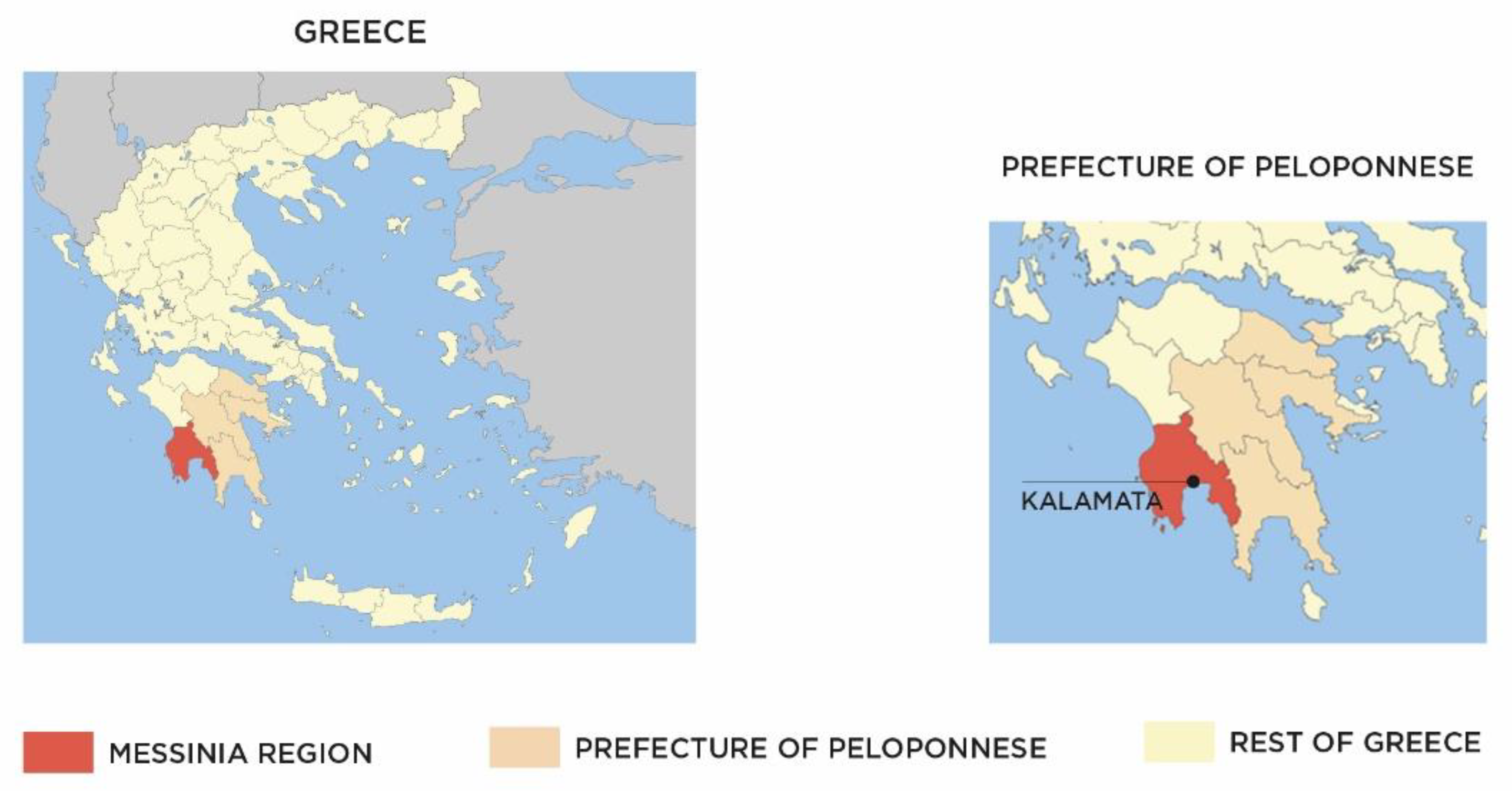
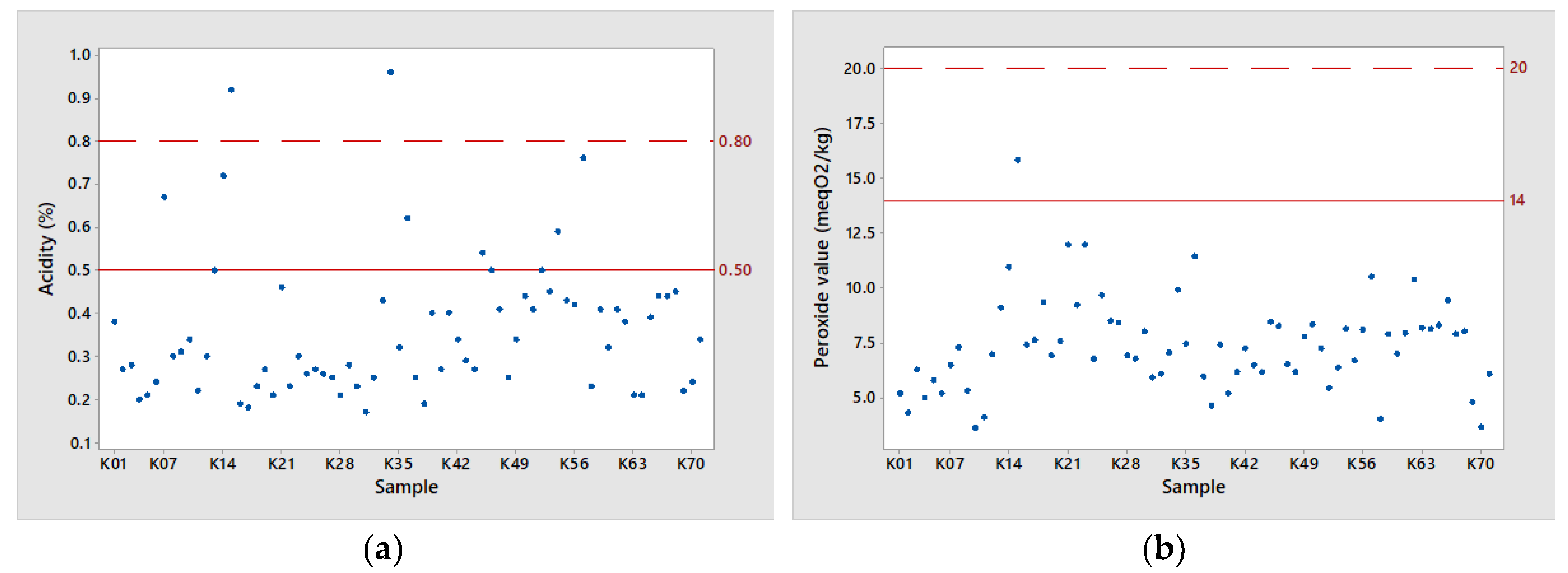
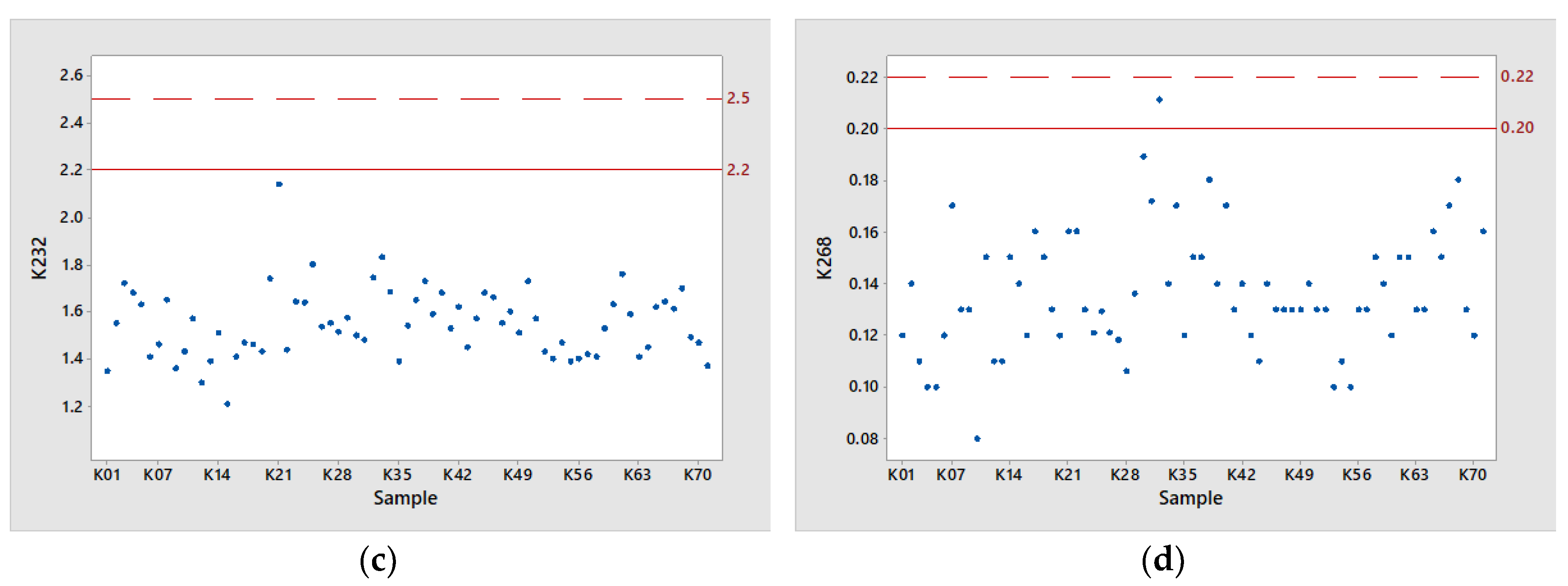
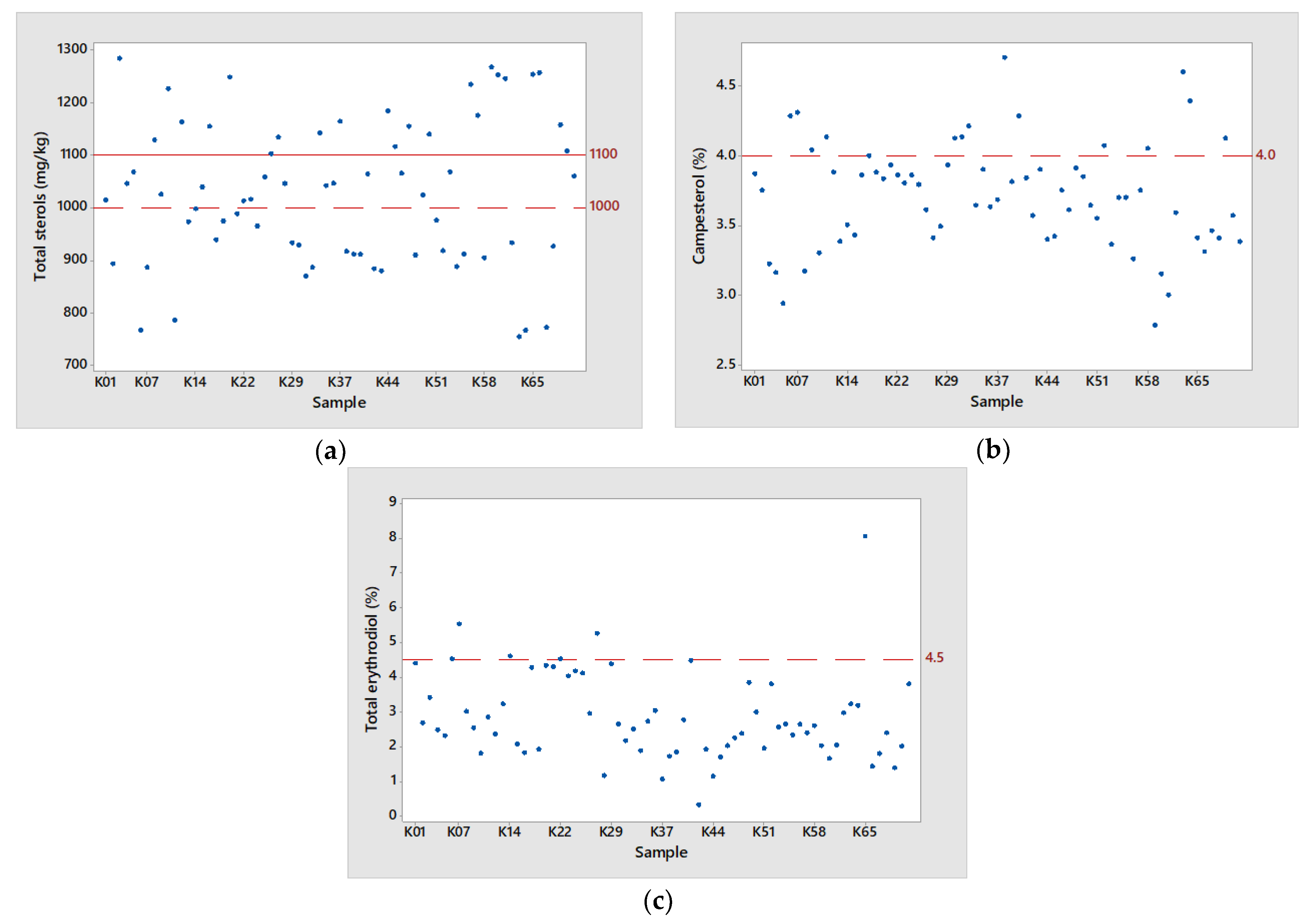
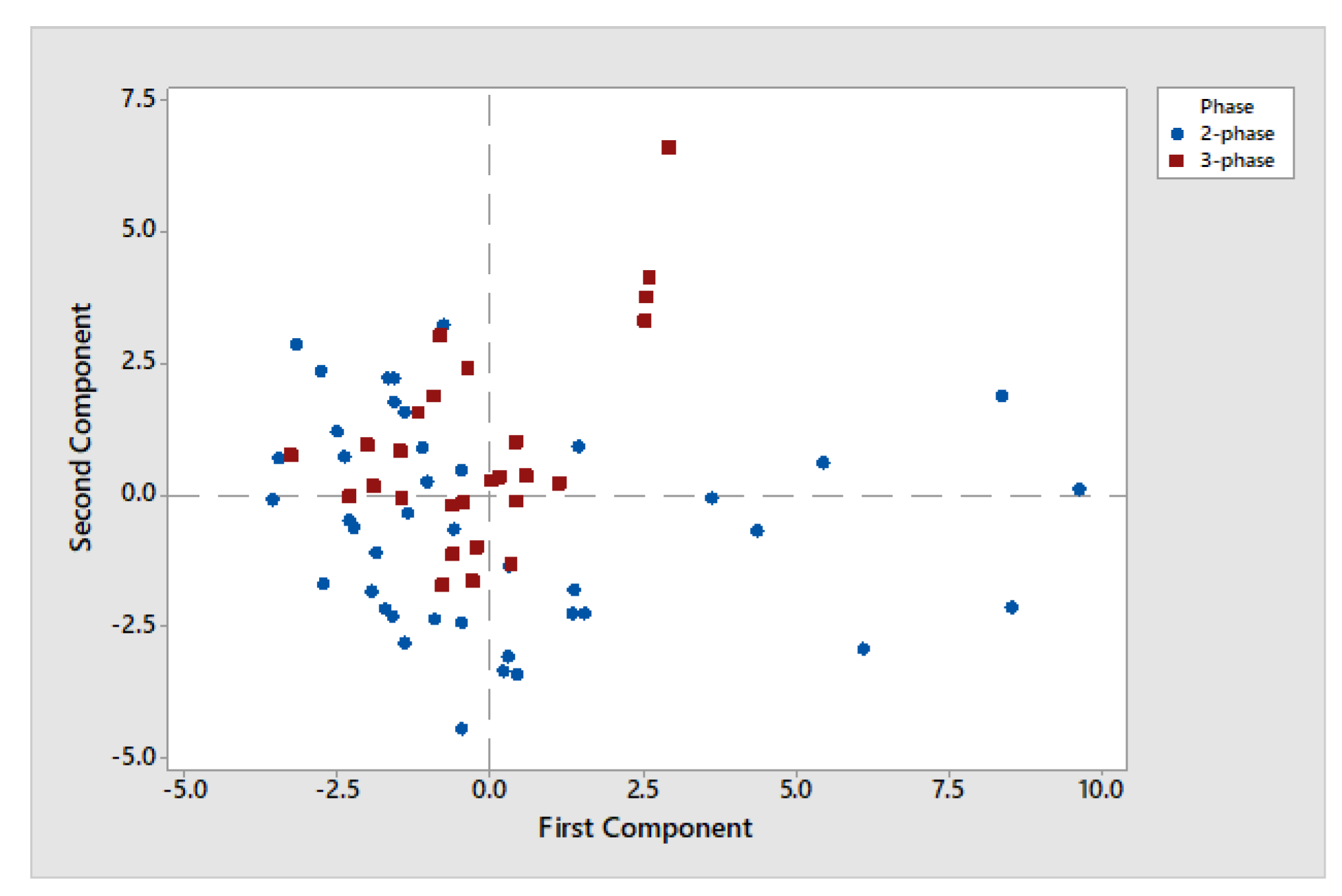
| Parameter | Mean ± SD | Min–Max | EEC Limit for the EVOO Category | PDO Limit |
|---|---|---|---|---|
| Free acidity (%) | 0.34 ± 0.13 | 0.17–0.76 | ≤0.80 | ≤0.50 |
| Peroxide value (meqO2 kg−1) | 7.24 ± 1.88 | 3.64–11.96 | ≤20 | ≤14 |
| K232 | 1.55 ± 0.14 | 1.33–2.14 | ≤2.50 | ≤2.20 |
| K268 | 0.13 ± 0.01 | 0.08–0.21 | ≤0.22 | ≤0.20 |
| Sterols and Triterpene Diols | Mean ± SD | EEC Limit | PDO Limit |
|---|---|---|---|
| Cholesterol (%) | 0.11 ± 0.03 | ≤0.5 | ≤0.5 |
| 24-methylene-cholesterol% | 0.32 ± 0.09 | ||
| Campesterol% | 3.71 ± 0.38 | ≤4.0 | ≤4.0 |
| Campestanol% | 0.05 ± 0.03 | <campesterol | <campesterol |
| Stigmasterol% | 0.74 ± 0.19 | ||
| Chlerosterol% | 0.85 ± 0.07 | ||
| β-Sitosterol% | 80.73 ± 3.73 | ||
| Sitostanol% | 0.37 ± 0.30 | ||
| Δ-5-avenasterol% | 12.28 ± 3.96 | ||
| Δ-5,24-stigm/dienol% | 0.29± 0.10 | ||
| Δ-7-stigmastenol% | 0.19 ± 0.09 | ≤0.5 | ≤0.5 |
| Δ-7-avenasterol% | 0.28 ± 0.11 | ||
| Apparent b-Sitosterol% | 94.63 ± 1.07 | ≥93.0 | ≥93.0 |
| Total erythrodiol% | 2.85 ± 1.25 | ≤4.5 | ≤4.5 |
| Total sterols (mg/kg) | 1033.3 ± 150.1 | ≥1000 | >1100 |
| Fatty Acid (%) | Mean ± SD | Min–Max | EEC Limit | PDO Limit | Two-Phase | Three-Phase | Difference p-Value |
|---|---|---|---|---|---|---|---|
| Mean ± SD | Mean ± SD | ||||||
| Myristic C14:0 | 0.01 ± 0.00 | 0.00–0.02 | ≤0.03 | 0.01 ± 0.00 | 0.01 ± 0.00 | n.s | |
| Palmitic C16:0 | 12.02 ± 0.74 | 9.54–13.56 | 7.50–20.00 | 10.0–15.0 | 11.96 ± 0.81 | 12.11 ± 0.61 | n.s |
| Palmitoleic C16:1 | 0.92 ± 0.13 | 0.64–1.43 | 0.30–3.50 | 0.6–1.2 | 0.93 ± 0.13 | 0.89 ± 0.08 | n.s |
| Heptadecanoic C17:0 | 0.05 ± 0.02 | 0.03–0.15 | ≤0.40 | 0.04 ± 0.01 | 0.06 ± 0.03 | 0.003 | |
| Heptadecenoic C17:1 | 0.08 ± 0.04 | 0.06–0.24 | ≤0.60 | 0.07 ± 0.01 | 0.10 ± 0.05 | 0.016 | |
| Stearic C18:0 | 2.53 ± 0.19 | 1.98–3.12 | 0.50–5.00 | 2.0–4.0 | 2.44 ± 0.16 | 2.67 ± 0.16 | 0.00 |
| Oleic C18:1 | 76.70 ± 1.96 | 70.67–81.40 | 55.00–83.00 | 70–80 | 76.92 ± 2.19 | 76.36 ± 1.52 | n.s |
| Linoleic C18:2 | 6.09 ± 1.60 | 4.20–12.01 | 2.50–21.00 | 4.0–11.0 | 6.05 ± 1.91 | 6.14 ± 0.95 | n.s |
| Linolenic C18:3 | 0.68 ± 0.07 | 0.51–0.86 | ≤1.00 | 0.66 ± 0.08 | 0.69 ± 0.06 | n.s | |
| Arachidic C20:0 | 0.44 ± 0.03 | 0.33–0.50 | ≤0.60 | 0.43 ± 0.04 | 0.45 ± 0.02 | 0.012 | |
| Eicosenoic C20:1 | 0.31 ± 0.02 | 0.27–0.35 | ≤0.50 | 0.31 ± 0.02 | 0.30 ± 0.02 | n.s | |
| Behenic C22:0 | 0.14 ± 0.01 | 0.09–0.17 | ≤0.20 | 0.14 ± 0.01 | 0.14 ± 0.01 | n.s | |
| Lignoceric C24:0 | 0.05 ± 0.00 | 0.034–0.08 | ≤0.20 | 0.05 ± 0.00 | 0.05 ± 0.00 | n.s |
| Parameter (mg/kg) | Mean ± SD | Min–Max | EEC Limit | PDO Limit |
|---|---|---|---|---|
| Wax Esters C40–C46 (WEs) | 67.20 ± 18.88 | 42.84–140.31 | ≤250 | ≤250 |
| Wax Esters C42–C46 (TWEs) | 28.38 ± 9.62 | 16.89–58.33 | ≤150 | ≤150 |
© 2019 by the authors. Licensee MDPI, Basel, Switzerland. This article is an open access article distributed under the terms and conditions of the Creative Commons Attribution (CC BY) license (http://creativecommons.org/licenses/by/4.0/).
Share and Cite
Skiada, V.; Tsarouhas, P.; Varzakas, T. Preliminary Study and Observation of “Kalamata PDO” Extra Virgin Olive Oil, in the Messinia Region, Southwest of Peloponnese (Greece). Foods 2019, 8, 610. https://doi.org/10.3390/foods8120610
Skiada V, Tsarouhas P, Varzakas T. Preliminary Study and Observation of “Kalamata PDO” Extra Virgin Olive Oil, in the Messinia Region, Southwest of Peloponnese (Greece). Foods. 2019; 8(12):610. https://doi.org/10.3390/foods8120610
Chicago/Turabian StyleSkiada, Vasiliki, Panagiotis Tsarouhas, and Theodoros Varzakas. 2019. "Preliminary Study and Observation of “Kalamata PDO” Extra Virgin Olive Oil, in the Messinia Region, Southwest of Peloponnese (Greece)" Foods 8, no. 12: 610. https://doi.org/10.3390/foods8120610
APA StyleSkiada, V., Tsarouhas, P., & Varzakas, T. (2019). Preliminary Study and Observation of “Kalamata PDO” Extra Virgin Olive Oil, in the Messinia Region, Southwest of Peloponnese (Greece). Foods, 8(12), 610. https://doi.org/10.3390/foods8120610




